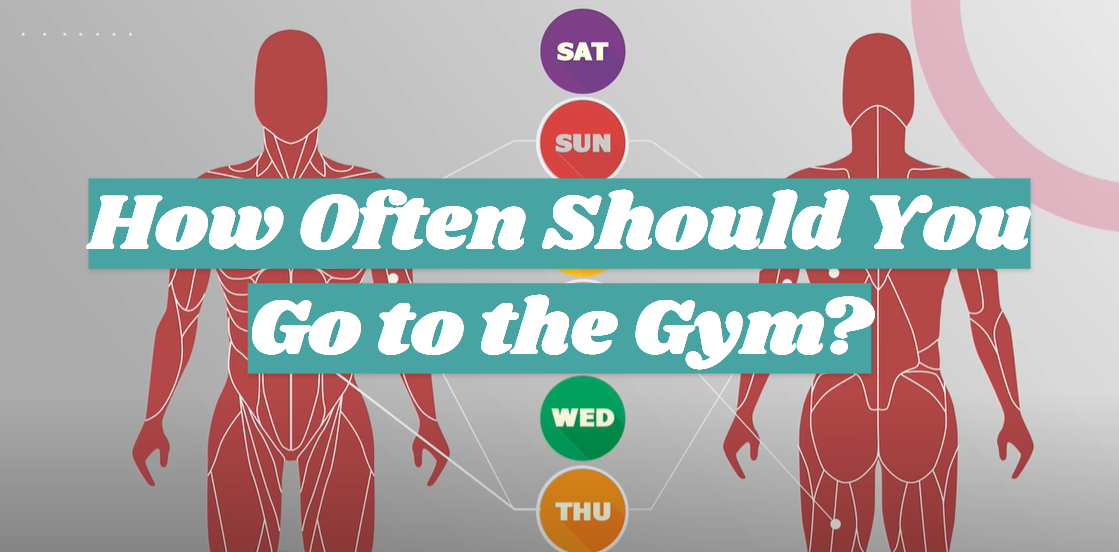Everyone’s fitness goals are different, but when it comes to finding the perfect exercise balance and the ideal gym frequency, it can be hard to know how much is too much or how little is not enough. From the casual gym-goer looking to stay healthy to the professional athlete training for a competition, understanding what’s best for your body and lifestyle can be a difficult task. Through research and analyzing your own habits, you can better understand the complexities of finding just the right amount of time in the gym.
The Factors That Determine How Many Days a Week Should You Work Out
Your Fitness Goals
Your fitness goals are the most important factor to consider when deciding how many days a week you should work out. If your goal is to lose weight and tone up, then it’s best to aim for 4-5 days of exercise per week. This will help you burn more calories and build muscle at a faster rate. Alternatively, if you are looking to maintain your current level of fitness, then 2-3 days a week should be enough.
Your Current Fitness Level
The number of days you will need to work out each week also depends on how fit you already are. If you’re starting from scratch and have never worked out before, then it’s best to start slowly with 1-2 days of exercise per week. As your fitness level improves, you can gradually increase the number of days and intensity of workouts.
Your Schedule
Of course, how many days a week you work out also depends on your schedule. If you have a very busy lifestyle, it might not be realistic to commit to working out 5 days a week. It’s important to find a balance between your exercise goals and the time available for you to dedicate to them.

Your Exercises
The type of exercise you choose can also affect how many days a week you should work out. If you focus on high-intensity exercises like weight lifting, HIIT workouts, or running, then you should aim for 3-4 days per week. On the other hand, if you prefer low-intensity activities like walking or yoga, then 2-3 days a week is sufficient.
Your Lifestyle
Your lifestyle choices can also play a role in determining how many days a week you should work out. If you lead an active lifestyle, then it’s that you won’t need to dedicate as much to working out each week. However, if you are more sedentary, then it’s important to make time for exercise to maintain your health and well-being.
Your Age and Experience
Last but not least, your age and experience level can also affect how many days a week you should work out. If you’re an older adult or a beginner, then it’s best to start with 2-3 days of exercise per week. As your fitness improves, you can gradually increase the number of workouts depending on your goals.
Ultimately, the number of days you should work out each week depends on a variety of factors including your fitness goals, current fitness level, schedule, type of exercises, and lifestyle choices. It’s important to find a balance that works for you so that you can get the most out of your workouts and maintain your health.

How often should you work out for weight loss?
The amount of physical activity you need to do for weight loss will depend on many factors, such as your age, physical condition, and goals. Generally speaking, it is recommended that adults should get at least 150 minutes of moderate-intensity aerobic exercise every week, or 75 minutes of vigorous-intensity aerobic exercise.
With any exercise plan, consistency is key to seeing results and keep motivated. Make sure to set realistic goals and take the necessary steps toward achieving them. With a combination of diet and exercise, you can reach your weight loss goals in no time!
How Frequently Should A Beginner Go To The Gym?
To Increase Fitness And General Health
The frequency of gym visits for a beginner should be determined by their own goals and fitness level. Generally, the recommendation is to start with two or three days per week, with each workout lasting around 30 minutes. For those who want to lose weight or improve their overall health, this can be increased to four or five days per week, with longer workouts if desired.
Additionally, beginners need to give their body time to recover after each workout session. This will help them to avoid overtraining and injuries while helping them reach their fitness and health goals more quickly. To aid in recovery, beginners should also focus on nutrition and sleep habits alongside gym sessions.
For Weight Loss
If the goal is specifically weight loss, then a beginner should aim to visit the gym three or four times per week. Each session should include both cardiovascular exercise and strength training to maximize results. To achieve the best possible outcome, sessions should be spaced out over a week so that muscles get adequate time to rest and recover between workouts.

To Build Muscle
Those looking to build muscle mass may need to increase their gym visits even further than those looking for general health benefits. As a guide, visiting the gym four or five days per week is recommended for those wanting to build muscle quickly and safely. Again, each session should involve both cardio and strength training exercises with enough rest days in between each workout for proper recovery [1].
How To Start A Gym Routine
- Set realistic goals: Before you set your gym routine, it’s important to decide what your fitness goals are and how much time and effort you are willing to put into reaching them. Be realistic when setting these goals so that you can reach them without feeling overwhelmed or discouraged.
- Choose a gym: Once you have decided on the type of workout routine you want to do, it is time to find a gym where you feel comfortable working out. Take time to look around for gyms with the equipment and amenities that will meet your needs as well as any specific safety protocols that may be necessary for COVID-19.
- Get familiar with the equipment: Take some time before starting your workout routine to become familiar with the equipment and how it works. Ask a gym staff member or personal trainer for help if you need it. This will ensure that you use the equipment safely and get the most out of your workout.
- Plan your routine: Once you have chosen a gym, it’s time to plan your workout routine. Decide what exercises and activities you want to include in your routine as well as when you are going to do them and how often. Be sure to allow yourself enough rest days so that your body can recover between workouts.
- Start slowly: When starting out at the gym, start off slow and focus on form rather than intensity right away. This will help prevent injuries and ensure that you are getting the most out of your workout.
- Find motivation: One of the key elements to sticking to a gym routine is finding motivation to keep going. Whether it’s joining a class, working out with friends or family, listening to music, or setting goals and rewards for yourself, find something that helps motivate you to stay consistent.
- Track your progress: Tracking your progress can be a great way to stay motivated and reach your fitness goals. Use various methods such as tracking how long you work out each day, how much weight you lift, how many reps you complete, etc., and make sure to celebrate small successes along the way.
- Don’t give up: It’s normal to feel frustrated or unmotivated while trying to stick to a gym routine. If you find yourself feeling this way, don’t give up! Take a break if needed and then try again when you feel ready. Remember that progress takes time and dedication, so be patient with yourself and stay focused on your goals.
With these tips in mind, you should have no problem starting and sticking to a gym routine that fits your needs. Don’t forget to take care of your body by stretching before and after each workout, eating nutritious foods, and getting enough rest [2].

The Benefits Of Regularly Going To The Gym
Regularly going to the gym can provide numerous benefits for both your physical and mental health. Physically, regular exercise at the gym can help keep your body strong, increase your energy levels and endurance, improve joint flexibility, reduce weight gain risk factors, and reduce stress. With regular exercise comes improved cardiovascular fitness, better posture and balance, and increased bone density. Additionally, improved muscle tone helps support proper joint alignment which reduces the risk of injury.
In addition to the physical and mental health benefits, going to a gym can provide additional social benefits as well. Networking with other gym members or joining group classes can be a great way to make friends and meet new people. Additionally, having someone to work out with can help motivate you when times are tough and offer an opportunity for companionship while exercising.
Overall, the advantages of regularly attending the gym are clear. Not only does it have numerous physical and mental health benefits but it also provides valuable social opportunities as well. So take some time out of your schedule each week to head down to the gym – your body will thank you [3]!
Determining your ideal workout frequency
Once you have established your goals, it’s time to determine how often you should work out. In general, most people should aim for about three to five days of exercise per week. However, this is not a hard and fast rule; some people may need more or less depending on their fitness level and personal preferences. For example, if your goal is to lose weight quickly or build a large amount of muscle mass, then you may want to increase your workouts up to six days per week with high-intensity strength training sessions.
On the other hand, if you are looking for more of an overall health boost or trying to maintain your current weight and shape, then two or three moderate-intensity workouts will likely be all that you need. It’s important to find a workout frequency that works best for you and your goals, so don’t be afraid to experiment and adjust as needed.
No matter what kind of exercise program you choose, be sure to give yourself at least one day off per week. This will help reduce the risk of overtraining and injuries while allowing time for your body to rest and recover properly. Additionally, it is important to focus on having an overall balanced routine that includes both strength training and aerobic exercises. This balance can help ensure that all major muscle groups are getting the attention they need while also providing cardiovascular benefits.
Finally, remember that consistency is key when it comes to any exercise program; even if you are only able to work out two days a week, do your best to stick with it and you will see results in no time.

Planning your protein intake
Planning your protein intake is an important part of a balanced diet. Eating the right amount can help you maintain good health and reach your fitness goals. It is recommended that adults consume 0.8 grams of protein per kilogram of body weight each day, while athletes may need more to support muscle growth and recovery.
When planning your meals, consider food sources that are high in protein such as meat, fish, eggs, legumes, nuts, and seeds. These foods are often also rich in essential vitamins and minerals that can help keep your body healthy. You don’t have to stick to only those sources when trying to meet your daily protein needs though. Protein-rich grains like quinoa or oats can work as well, and dairy products such as milk or yogurt are also excellent sources.
Adding protein powder to smoothies or shakes can be a convenient way to get your daily requirement too. It is important to remember that you should never go overboard with protein consumption. Eating too much can put unnecessary strain on the kidneys and other organs and may even lead to health issues in the long run. To ensure that you’re consuming the right amount for your body, talk to a nutritionist who can help plan out meals that meet your individual needs. With their expertise, you’ll be able to achieve optimal health without going overboard on any particular macronutrient.
FAQ
Is 3 times a week enough to work out?
This is a difficult question to answer as how much exercise you need depends on your goals and fitness level. Generally, it is recommended that adults should do at least moderate physical activity for 30 minutes at least five days per week. However, if your goal is just to maintain your current level of overall health and fitness, then three times per week may be enough. It’s important to find something that works for you – whether that’s three or five days each week – and stick with it. Additionally, it can also be beneficial to mix up the types of exercises you do so that your body doesn’t adapt too quickly and become less challenged over time.
What types of workouts are best?
The best type of workout depends on your goals and current level of fitness. If you’re a beginner, then it’s best to start with low-impact exercises such as walking or swimming to get used to the feeling of exercising regularly. Once you become more accustomed to physical activity, then you can look into more intense activities such as running or weight lifting. It’s important to find something that works for you and that you enjoy doing – if exercise is not enjoyable for you, then it may be difficult to stick with it in the long run.
How long should I exercise for?
It’s recommended that adults do at least 30 minutes of moderate physical activity each day, but this can vary depending on your goals and fitness level. For example, if your goal is to lose weight then you may need to exercise for longer periods or incorporate more intense activities into your routine. Ultimately, it’s important to find a workout routine that works well for you and that you enjoy doing – this will make it easier to stick with in the long run.

What should I do if I’m not seeing results?
If you’re not seeing results from your current workout routine, then it’s important to evaluate what could be causing the lack of progress. It could be that the exercises themselves are too easy or that you’ve become accustomed to them over time, so introducing new exercises or increasing intensity can help challenge your body again and promote further progress.
Additionally, it’s important to make sure you’re getting enough rest between workouts and eating a nutritious diet – both of these can affect overall performance and results. If you’ve been consistent with your exercise routine but still aren’t seeing results, then it may be beneficial to consult with a fitness professional who can help create a plan that better fits your goals. They can also provide guidance and support if needed.
Is it good to go to the gym every day?
It is generally not recommended to go to the gym every day as it can be hard on your body and can lead to burnout. Additionally, if you’re doing the same exercises every day then your body will quickly become accustomed to them and progress may slow down or stop. It’s best to mix up your routine and give yourself at least 1-2 days of rest each week to allow your muscles time to recover. This will help prevent injury and ensure that your workouts are beneficial in the long run.
Can I get fit without going to a gym?
Yes, it is possible to get fit without going to a gym! There are plenty of exercises that don’t require any equipment or even much space. Walking, running, bodyweight exercises, and swimming are all great options that can be done anywhere. Additionally, there are many online resources with workouts you can do at home if you prefer to exercise in the comfort of your own home. Overall, it’s important to find something that works for you and that you enjoy doing – this will make it easier to stick with in the long run. With some creativity and dedication, it is possible to get fit without a gym membership!
Is working out 5 days a week enough?
This depends on the type of exercise you are doing and your goals. For most people, 5 days a week is enough to maintain their current fitness level. However, if you are looking to make progress or gain muscle mass then it may be beneficial to increase the frequency of your workouts or increase the intensity of each session. Ultimately, it’s important to find a routine that works well for you and that you enjoy doing – this will make it easier to stick with in the long run.
What can 1 month of gym do?
One month of consistent gym attendance can have a significant impact on your overall fitness level. Depending on the exercises you do and how often you attend, it is possible to see improvements in strength, endurance, flexibility, and even body composition. Additionally, just one month of regular exercise can help improve your mental health by reducing stress and improving your mood. Ultimately, it’s important to find a routine that works well for you and that you enjoy doing – this will make it easier to stick with in the long run.
Useful Video: How Many Times A Week Should You Workout (Science-Based)
Conclusion
The frequency of training in the gym can be a major factor in achieving fitness goals. Therefore, it is important to choose the right frequency for each type of exercise and adjust it according to one’s needs and capabilities. There is no single answer to how often you should work out, as everyone’s physical fitness levels are different., generally speaking, three or four days per week of all-around exercises such as running, weight training, swimming, and yoga can provide great results and help achieve desired health outcomes over time. The frequency of exercise should be tailored to individual needs while taking into account any medical conditions or constraints.
References:
- https://health.clevelandclinic.org/how-often-you-should-work-out/
- https://www.mayoclinic.org/healthy-lifestyle/fitness/in-depth/fitness/art-20048269
- https://www.cdc.gov/physicalactivity/basics/pa-health/index.htm










Leave a Review